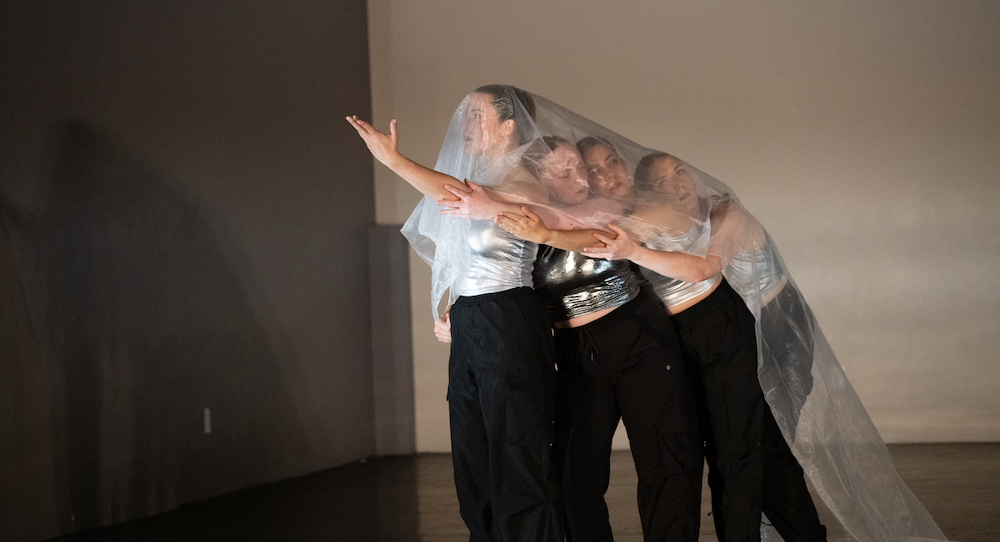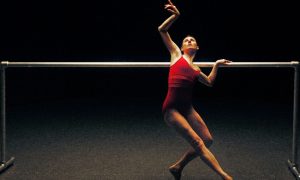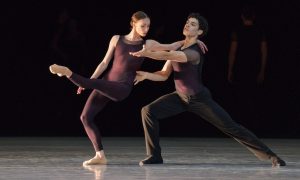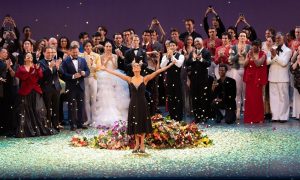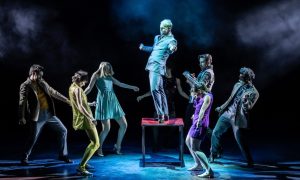Mass Motion Dance, Brighton, MA.
July 14, 2025.
“We’re entering a new era and pushing further than we ever have before,” affirmed Artistic Director Dana Alsamsam, speaking to the company’s recent rebranding: formerly Nozama Dance Collective, now Novum Dance Collective. N2 continues into this new era, with this program as the fifth annual.
Alsamsam also noted how this intimate showing is always exciting because it’s a chance to truly invite audience members in, “no matter what your relationship to dance is.” N2, as a concept, even feels like an invitation into how these works develop; Alsamsam explained how many works here are “in process”, and will be shown in the company’s December 2025 showing.
As another part of that invitation, each choreographer got a chance to speak before their work, offering context and anything else they might want to share. Along with dancers drinking water and their waiting in the wings being visible, those sharings seemed like a dropping of the “mystique” — the mystery and separation between artists and audience. New name, same human vulnerability and openness – not to mention ferocity and rigor within the work itself…I was invested from the start.
That start was an excerpt from Jami Adam’s Amore Mio – My Love. She described it as “rooted in memory and connection”, offering a casual and lighthearted quality – and it felt just like that, beautifully so. The work’s inspiration lay in the Italian music playing in her childhood home, something that carries through to her current life with her partner, she shared.
Movement began with simple stepping patterns, but developed quickly into athleticism of leaps and subtleties of undulating spines. The Italian music score (Guaglione from Aurelio Fierro), as well as the dancers’ red skirts, contributed to the work’s wholesome feel. Playful gestures and hip rolls added light-hearted sweetness. I felt the presence of that Italian zest for good laughs, good food, good life – I can say as a second generation Italian-American. It may be an Olive Garden tagline, but it really is true: when you’re here, you’re family. That zestful energy escalated to dancers moving in fast curricular patterns until they ultimately fell to the ground, the work finito.
Madison Florence’s compelling and evocative From the Bottom of My Breath (its world premiere here) paralleled the breath cycle with calm, rage and sorrow. She described experiencing these emotions in a cycle of its own, and encouraged audience members to come along that journey as well. Deep, audible exhales evoked the calm of the opening. Repeated gestures, and movements in and out of a held plank, embodied the even and rhythmic quality of calm breathing. Dancers rose to higher levels, adding visual variance – yet harmony continued resonating through their formations, timing and shaping. Their soft, yet assured movement quality felt meditative.
Calm moved into rage with an abrupt shift: runs, screams, expansive and muscular movements, pounding drums in the score. In formation, the ensemble rocked their weight back and forth from foot to foot – a defensive posture. Other dancers, however, broke away into other vocabulary; anger, like any emotion, can have many layers to it – and some of those layers can be wayward.
Falling to the floor with tears signaled the coming of sorrow. Movement appeared to be seeking, searching, restless and rootless. One may not expect that of sadness, but there can be an urgency to it, of trying to find a way out of the experience or at least understand it better. Movement from the first section implied a cycle – and, just like breathing, emotions can certainly be that. Indeed, the ensemble finished in the opening tableau. In all of these ways, the work was a keen and thoughtful visceral depiction of how we experience these emotions.
Juliana Willey-Thomas’ Love in Time offered one of five parts in the full work-in-progress, a touching and tender solo danced by Alsamsam. The full work portrays love at different stages of the lifespan, and this section appeared to depict the sweet innocence of teenage love. In this piece in particular, I appreciated the casual production values of this intimate, low-key showing; her dancing shadow on the light-colored back wall at times entranced me. Her tutu had me thinking of a young girl yearning to be a ballerina, even while – her also using a dial-up phone prop – she was old enough to be enjoying long giggly phone calls with school friends.
Alsamsam danced with a breezily expansive quality, letting the movement resonate and lengthen through her. Her musicality was also superb, smoothly tangoing with the rhythms and textures of the pop R&B tunes (Rickey Nelson’s “Teenager’s Romance” and Aretha Franklin’s “Don’t Say You’re Sorry Again”).
Along with that harmony and tenderness was turbulence, however; hard-hitting gestures and the resignation of falling to the floor made visceral the storms and growing pains of youth. Alsamsam’s persona walked off with the phone, very much not letting it go – how “teenager” of her! I very much look forward to seeing the other four parts; I’m quite interested to see how qualities, themes, et cetera will carry through as well as differ.
An excerpt from Alsamsam’s bold and memorable Work in Progress DYSTOPIC closed the show, which I reviewed – with great pleasure – in July of 2024. Alsamsan explained the concept of the work’s two opposing groups as an underground resistance and those enforcing dystopia. Hearing that, I was fascinated to see how that information might alter my experience of the work.
I believe that I saw the same spatial tension, clear opposition and kinetic clarity that I saw the first time – which speaks well of the work, I think, in its clear conveying of feeling and theme if not a specific narrative. Context around a work can enrich and expand how one engages with it, yet – in this humble writer’s opinion – it doesn’t need to.
The program ultimately closed with each dancer having their own bow and Alsamsam calling them each by name – not something I’ve seen before, I don’t think. Given how dancers can feel like tools in a larger vision, rather than their own distinct and self-determining individuals, that warmed my heart. Arts organizations begin, change, even (sadly) sometimes end – artists remain. I eagerly await what these talented and committed ones will share next.
By Kathryn Boland of Dance Informa.


